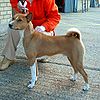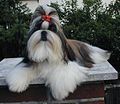Ancient dog breeds
[1]Fourteen ancient breeds of dog have been identified through advances in DNA analysis.[2] These breeds of domesticated dog show the fewest genetic differences from wolves.
Research
[edit]
| ||||||||||||||||||||||||||||||
| Cladogram of ancient dog breeds. |
DNA from dogs of 85 (mostly) AKC-registered breeds (5 individuals per breed in most cases) were tested by Parker et al.[2] This study had some surprises, especially the suggestion that three breeds – the Norwegian Elkhound, Pharaoh Hound, and Ibizan Hound – are not as old as typically stated, but rather are more recent recreations of old types.[2] Also, five pairs of breeds are closely related: 1)Alaskan Malamute and Siberian Husky, 2) Collie and Shetland Sheepdog, 3)Greyhound and Whippet, 4) Bernese Mountain Dog and Greater Swiss Mountain Dog, and finally the 5) Bull Mastiff and English Mastiff.[2]
However, the assumption that a small sample from a single dog breed can be representative for the entire breed is argued to be invalid by long-time repeated incidental or intentional interbreeding with local dogs, thereby gradually replacing original wolf clade elements but maintaining the original phenotype by ongoing selection for the original use and conformation.
At the time that dogs diverged from the wolf, humans were nomadic hunter-gatherers who had not yet domesticated any another animal, as humans did not remain in one place for long enough to raise or keep animals. Humans still indirectly spurred the speciation event that caused wolves to eventually become the dog.[3] Genetic analysis shows that one of the primary mechanisms underlying the speciation began with mutations that randomly occurred in wolf genes AMY2B, MGAM and SGLT1 for independent populations of wolves. The mutations increased the expression of these gene loci by nearly 7.4 fold, which conferred the ability to much more effectively digest and utilize nutrients from starches and fats.[4]
The implications of these mutations can be seen in archeological records that show that dog ancestors began to follow groups of nomadic humans and eat the more starchy and fatty leftovers of the foods humans ate.[5] This caused changes in the morphology of the wolf snout and teeth which became shorter and more adapted to eating a variety of different foods rather than the original function of hunting and taking down large prey. The morphology of the wolf brain also changed in the areas of the limbic system having to do with fight or flight responses. These areas began to shrink by 20-40%; enabling wolves to be less afraid of humans and more willing to live and interact in close proximity to them.[6]
On an ontogenetic developmental level, these wolves eventually evolved much higher social-cognitive skills with humans; they were able to incorporate humans into their social hierarchal system as the new “alpha” or dominant member of society. This led to a much greater degree of obedience, and the ability to process emotional signals from humans, including an understanding of subtle communicative cues such as the importance of what a human is looking at.[7]
[8] Also, as there are some 400 known dog breeds (of which the AKC recognizes 167), it is possible that an extended study would reveal additional "ancient" breeds.
Gallery of the fourteen ancient breeds
[edit]References
[edit]- ^ Schoenebeck, J. J.; Ostrander, E. A. (8 February 2013). "The Genetics of Canine Skull Shape Variation". Genetics. 193 (2): 317–325. doi:10.1534/genetics.112.145284.
- ^ Jump up to: a b c d Parker, H.G.; Kim, L.V.; Sutter, N.B.; Carlson, S.; Lorentzen, T.D.; Malek, T.B.; Johnson, G.S.; DeFrance, H.B.; Ostrander, E.A.; Kruglyak, L. (2004-05-21). "Genetic structure of the purebred domestic dog" (PDF). Science. 304 (5674): 1160–4. doi:10.1126/science.1097406. PMID 15155949.
- ^ Wang, Guo-dong; Zhai, Weiwei; Yang, He-chuan; Fan, Ruo-xi; Cao, Xue; Zhong, Li; Wang, Lu; Liu, Fei; Wu, Hong; Cheng, Lu-guang; Poyarkov, Andrei D.; Poyarkov JR, Nikolai A.; Tang, Shu-sheng; Zhao, Wen-ming; Gao, Yun; Lv, Xue-mei; Irwin, David M.; Savolainen, Peter; Wu, Chung-I; Zhang, Ya-ping (14 May 2013). "The genomics of selection in dogs and the parallel evolution between dogs and humans". Nature Communications. 4: 1860. doi:10.1038/ncomms2814.
- ^ Axelsson, Erik; Ratnakumar, Abhirami; Arendt, Maja-Louise; Maqbool, Khurram; Webster, Matthew T.; Perloski, Michele; Liberg, Olof; Arnemo, Jon M.; Hedhammar, Åke; Lindblad-Toh, Kerstin (23 January 2013). "The genomic signature of dog domestication reveals adaptation to a starch-rich diet". Nature. 495 (7441): 360–364. doi:10.1038/nature11837.
- ^ Larson, G.; Karlsson, E. K.; Perri, A.; Webster, M. T.; Ho, S. Y. W.; Peters, J.; Stahl, P. W.; Piper, P. J.; Lingaas, F.; Fredholm, M.; Comstock, K. E.; Modiano, J. F.; Schelling, C.; Agoulnik, A. I.; Leegwater, P. A.; Dobney, K.; Vigne, J.-D.; Vila, C.; Andersson, L.; Lindblad-Toh, K. (21 May 2012). "Rethinking dog domestication by integrating genetics, archeology, and biogeography". Proceedings of the National Academy of Sciences. 109 (23): 8878–8883. doi:10.1073/pnas.1203005109.
- ^ Driscoll, C. A.; Macdonald, D. W.; O'Brien, S. J. (15 June 2009). "From wild animals to domestic pets, an evolutionary view of domestication". Proceedings of the National Academy of Sciences. 106 (Supplement_1): 9971–9978. doi:10.1073/pnas.0901586106.
- ^ Riedel, Julia; Schumann, Katrin; Kaminski, Juliane; Call, Josep; Tomasello, Michael (March 2008). "The early ontogeny of human–dog communication". Animal Behaviour. 75 (3): 1003–1014. doi:10.1016/j.anbehav.2007.08.010.
- ^ Quignon, Pascale; Herbin, L.; Cadieu, E.; Kirkness, E.F.; Hédan, B.; Mosher, D.S.; Galibert, F.; André, C; Ostrander, E.A.; Hitte, C. (2007-12-19). Awadalla, Philip (ed.). "Canine Population Structure: Assessment and Impact of Intra-Breed Stratification on SNP-Based Association Studies". PLoS ONE. 2 (12): e1324. doi:10.1371/journal.pone.0001324. PMC 2129117. PMID 18091995.
{{cite journal}}: CS1 maint: unflagged free DOI (link)
Further reading
[edit]- Derr, Mark (2004-05-21). "Collie or Pug? Study Finds the Genetic Code". The New York Times.
- Petura, Barbara Bradley (2004). "New Breakthrough in Dog Genetics". The Racing Siberian Husky Online & WorkingDogWeb.com. Retrieved 2008-05-10.
- Travis, John (2004-05-19). "Breeds Apart: Purebred dogs defined by DNA differences". Science News. 165 (21). Retrieved 2008-05-10.














